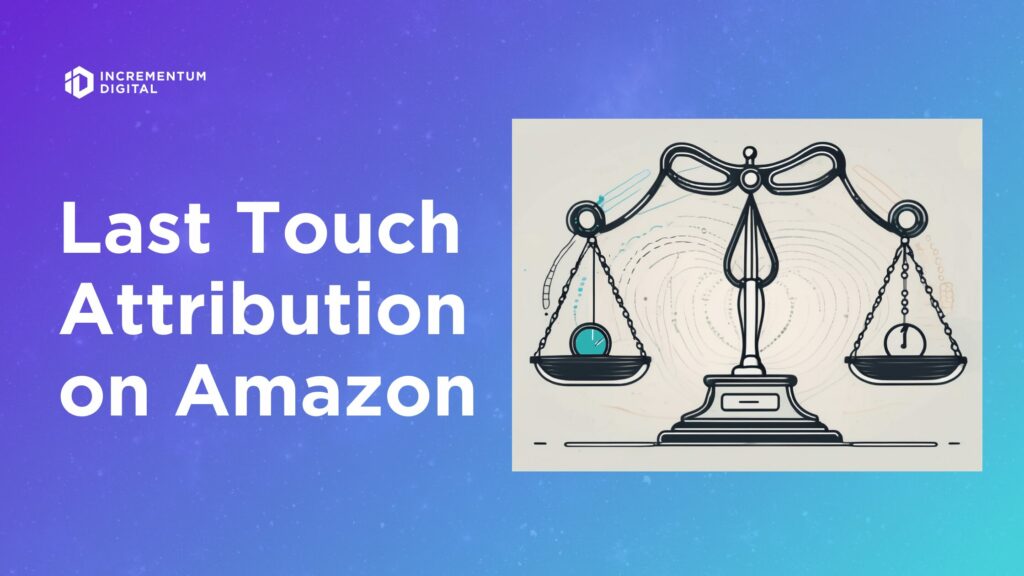Amazon Advertising
Here’s Why Last Touch Attribution Isn’t Serving Your Amazon Business Anymore

Here’s Why Last Touch Attribution Isn’t Serving Your Amazon Business Anymore
In the rapidly evolving world of e-commerce, understanding the effectiveness of your marketing efforts is crucial to the success of your Amazon business. One key aspect of this understanding is attribution modeling, which helps you identify which marketing touchpoints contribute to conversions and sales. However, relying solely on last touch attribution may no longer be the best strategy for Amazon sellers. In this article, we will explore the limitations of last touch attribution and why it may be time to consider alternative approaches.

Learn How to Make Listings That Convert in 2025!
Read our step-by-step guide on how to optimize your listings using Rufus AI insights. Sign up for our newsletter and get your copy for free!
Show me how
What is Last-Touch Attribution?
Last touch attribution is a model that assigns all the credit for a conversion or sale to the final touchpoint before the customer’s purchase. It disregards the customer’s previous interactions with other marketing touchpoints and assumes that the last touchpoint was the sole driver of the conversion.
For example, imagine a customer searching for a specific product on Amazon. They might click on a Sponsored Product ad, visit your product listing page, leave without making a purchase, then later return to Amazon directly and purchase the product. In a last touch attribution model, the sale would be credited entirely to the direct visit, overlooking the initial engagement through the Sponsored Product ad.
Understanding the Limitations of Last Touch Attribution on Amazon
As an Amazon seller, navigating the complex world of marketing attribution is crucial for optimizing your strategies and maximizing your sales. One commonly used method is last touch attribution, which credits the final marketing touchpoint a customer interacts with before making a purchase. While this approach can offer valuable insights into conversion paths, it is important to recognize its limitations to gain a more comprehensive understanding of the customer journey.
When relying solely on last touch attribution, it is essential to acknowledge its inherent shortcomings. One key limitation is the failure to account for the entire customer journey. Customers often engage with multiple touchpoints and marketing channels before ultimately making a purchase on Amazon. By focusing solely on the last touchpoint, you may overlook the critical role played by earlier interactions in influencing the buying decision.
Furthermore, last touch attribution overlooks the significance of brand awareness and exposure that may have been established through previous touchpoints. Building a strong brand presence is essential for driving customer loyalty and repeat purchases. By neglecting the impact of earlier touchpoints, you may miss out on valuable insights that could enhance your overall marketing strategy and customer retention efforts.
Challenges with Last Touch Attribution in the Amazon Ecosystem
Within the Amazon ecosystem, last touch attribution faces unique challenges that further limit its effectiveness. One of the main challenges is the presence of numerous touchpoints within the customer journey, both on and off Amazon.
Amazon’s vast array of advertising options, such as Sponsored Products, Sponsored Brands, and Display Ads, make it difficult to attribute conversions to a single touchpoint. Additionally, customers may interact with your brand through external sources such as social media, email marketing, or influencer collaborations. Ignoring these touchpoints can lead to an incomplete understanding of your marketing impact on Amazon.
Furthermore, Amazon’s closed platform restricts access to detailed data and analytics, making it challenging to track and measure each touchpoint accurately. This lack of visibility can limit your ability to optimize campaigns and allocate resources effectively.
Another significant challenge in the Amazon ecosystem is the dynamic nature of consumer behavior. Customers often engage with multiple touchpoints before making a purchase decision, creating a complex web of interactions that cannot be accurately captured by last touch attribution alone. Understanding the entire customer journey, from awareness to conversion, is crucial for developing a comprehensive marketing strategy on Amazon.
Moreover, the competitive landscape on Amazon adds another layer of complexity to last touch attribution. With numerous sellers vying for customer attention, attributing a conversion solely to the last touchpoint may not provide a complete picture of the factors influencing a purchase. Factors such as product reviews, pricing, and competitor strategies can all play a significant role in shaping consumer decisions within the Amazon marketplace.
How has Last-touch Attribution been Affecting my KPIs on Amazon?
The exclusive reliance on last touch attribution can skew your key performance indicators (KPIs) and mislead you into making suboptimal decisions. Let’s examine some of the ways that last touch attribution may misrepresent your marketing efforts on Amazon:
- Undervaluing early touchpoints: By attributing all the credit to the last touchpoint, you fail to recognize the impact of earlier marketing efforts. For example, if a customer discovered your brand through a social media ad and later made a purchase on Amazon, last touch attribution would ignore the role of social media in driving the conversion.
- Overemphasizing direct visits: Direct visits to your Amazon listing tend to receive all the credit in a last touch attribution model. However, many factors can influence a customer’s decision to visit your listing directly, such as prior exposure to your brand or positive word-of-mouth. By overemphasizing direct visits, you may underestimate the influence of other touchpoints.
- Misjudging the impact of retargeting: Retargeting campaigns can be highly effective in re-engaging customers who have shown interest in your products. However, last touch attribution fails to acknowledge the role of retargeting touchpoints in converting hesitant customers. This can lead to a decrease in investment in retargeting efforts.
The Rise of Multi-Touch Attribution Models for Amazon Sellers
Recognizing the limitations of last touch attribution, many Amazon sellers are turning to multi-touch attribution models, which provide a more comprehensive view of the customer journey. Unlike last touch attribution, multi-touch models assign credit to multiple touchpoints based on their contribution to the conversion.
In a multi-touch attribution model, various methods can be used to distribute credit among the touchpoints. Examples include the linear model, which assigns equal credit to each touchpoint, and the time decay model, which assigns more weight to recent touchpoints.
By implementing multi-touch attribution, Amazon sellers can gain a deeper understanding of their customers’ buying behavior and make more informed marketing decisions. This approach allows for a more accurate assessment of the effectiveness of individual touchpoints and a better allocation of resources.
Amazon’s Latest Attribution Modeling Updates
Recognizing the need for improved attribution strategies, Amazon has recently introduced updates to its attribution modeling capabilities. These updates aim to provide sellers with more robust and reliable insights into the impact of their marketing efforts.
Amazon Attribution, the platform’s proprietary attribution solution, offers a range of features that help sellers measure the impact of their non-Amazon marketing channels on Amazon sales. By leveraging unique codes and tracking pixels, sellers can attribute sales and conversions to specific touchpoints outside of Amazon’s ecosystem.
Additionally, Amazon is continuously expanding its advertising offerings and native reporting capabilities, providing sellers with more granular data and greater visibility into the customer journey. These updates empower sellers to gain more accurate insights and optimize their marketing strategies accordingly.
Implementing a Multi-Touch Attribution Strategy for Your Amazon Business
If you’re ready to move beyond last touch attribution and embrace a multi-touch approach, here are some key steps to get you started:
- Define your customer journey: Understand the various touchpoints that customers may encounter before making a purchase on Amazon. This could include external platforms, organic search, advertising campaigns, and more.
- Select an attribution model: Choose a multi-touch attribution model that best aligns with your business goals and resources. Consider factors such as the complexity of your marketing mix, available data, and the level of detail you require.
- Implement tracking and measurement: Utilize Amazon Attribution and other available tools to track and measure the effectiveness of different touchpoints. Ensure that your tracking setup captures data accurately and provides you with the insights you need.
- Analyze and optimize: Regularly review and analyze the data from your multi-touch attribution model. Identify trends, patterns, and areas of optimization to improve your marketing strategies and drive better results on Amazon.
Future Trends in Attribution Modeling for Amazon Sellers
As the e-commerce landscape continues to evolve, it’s important to stay informed about emerging trends in attribution modeling. Here are a few notable trends to consider:
- Advanced machine learning: Machine learning algorithms can analyze vast amounts of data to uncover complex patterns and insights. Leveraging machine learning in your attribution modeling can provide more accurate and detailed attribution results.
- Integration of offline data: As more businesses operate in both online and offline spaces, integrating offline data into attribution models becomes crucial. This integration allows for a more holistic view of the customer journey and can lead to more accurate attribution insights.
- Customized attribution approaches: Every business is unique, and different attribution models may work better for different industries and strategies. Customizing your attribution approach based on your specific needs and goals can lead to more meaningful insights and actionable strategies.
Leveraging Data-Driven Attribution Strategies for Amazon Success
In conclusion, relying solely on last touch attribution may no longer provide a comprehensive understanding of your marketing efforts on Amazon. By embracing multi-touch attribution models and leveraging the latest attribution modeling updates from Amazon, you can gain deeper insights into your customer journey and make data-driven decisions to improve your Amazon business.
Remember, implementing a multi-touch attribution strategy requires careful planning, tracking, and analysis. Regularly reassess your attribution model to ensure it aligns with your evolving marketing mix and business goals. By doing so, you can unlock the full potential of your marketing efforts on Amazon and drive your business towards success.
LET’S DISCOVER WHAT’S POSSIBLE FOR YOUR BRAND
We’re here to listen and uncover opportunities tailored to your unique goals.
Fill out the form to get started, and you’ll walk away with real insights and actionable recommendations—whether we work together or not.
- HANDS-ON LEADERSHIP
- AWARD-WINNING PARTNERSHIPS
- CUSTOM-BUILT SOLUTIONS







